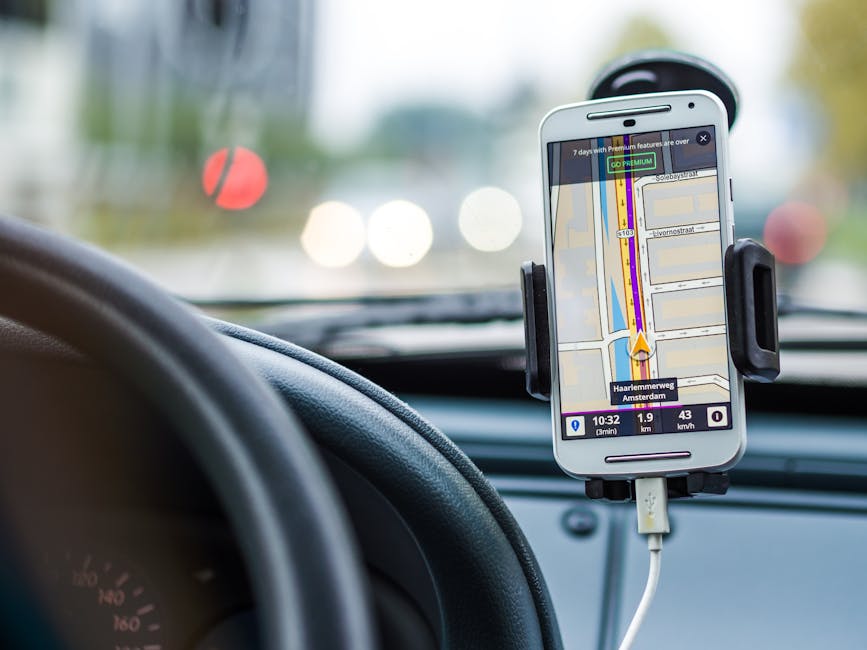What's The Best Way To Calculate Driving Distance? We've Got You Covered
Determining the most accurate and efficient method for calculating driving distances is a paramount concern for individuals seeking control over their travel plans. In this article, we explore various techniques that can assist in precisely measuring the distance of a journey.
By utilising online map services, GPS navigation systems, mobile apps, manual calculation with maps, or consulting road atlases and guidebooks, travellers can make informed decisions about their routes and estimated arrival times. Employing objective and analytical approaches, this article examines each method's advantages and disadvantages based on data-driven evidence.
We aim to provide an academic exploration of these techniques without personal bias or subjective opinions. With these comprehensive insights at hand, readers will be equipped to choose the best approach to calculate driving distances accurately while retaining full control over their travel endeavours.
Key Takeaways
- Online map services offer convenience, accuracy, real-time traffic updates, and customisation options for calculating driving distances.
- GPS navigation systems have replaced traditional paper maps, provide real-time traffic updates, and offer customisation options.
- Mobile apps are popular and reliable, incorporate traffic updates, and often integrate with ride-sharing services.
- Manual calculation with a map provides accuracy and nostalgia, but requires map reading skills.
Using Online Map Services

Online map services provide a convenient and efficient means of determining the driving distance between two locations, offering users a user-friendly interface that displays detailed route information along with real-time traffic updates. These services have become increasingly popular due to their accuracy in calculating driving distances. Accuracy is crucial when it comes to determining travel time and planning routes, as even a slight miscalculation can lead to delays or detours.
One way to assess the accuracy of driving distance calculations on online map services is by comparing them with other reliable sources, such as physical maps or GPS devices. Studies have shown that online map services generally provide accurate results, with minimal discrepancies compared to alternative methods. However, it is important to note that occasional errors may still occur due to factors such as road closures or inaccurate data input.
In addition to accuracy, the speed and efficiency of different online map services for calculating driving distances can also vary. Some platforms may utilise advanced algorithms and extensive databases to quickly generate route options based on real-time traffic conditions. Users can compare these options and choose the most optimal route based on their preferences, whether it be the shortest distance or avoiding congested areas during peak hours.
Transitioning into the subsequent section about GPS navigation systems, it is worth noting that many online map services are integrated into portable GPS devices or smartphone applications equipped with GPS capabilities. This combination provides users with an all-in-one solution for navigation purposes.
GPS Navigation Systems

GPS navigation systems provide a reliable means of determining the most efficient route to a destination by utilising cutting-edge technology and mapping algorithms. These systems offer several advantages for users who desire control over their driving experience.
Firstly, one key advantage of GPS navigation systems is the provision of real-time traffic updates. By accessing information from various sources such as traffic cameras and sensors imbedded in roadways, these systems can accurately detect congestion, accidents, or other disruptions on the road. This allows users to make informed decisions about alternative routes, saving time and avoiding unnecessary delays.
Secondly, GPS navigation systems have significantly impacted traditional paper maps and atlases. With the advent of digital navigation tools, the need for cumbersome physical maps has diminished. The convenience and accuracy offered by GPS navigation systems have made them the preferred choice for many drivers. Additionally, these systems are continually updated with new roads, landmarks, and points of interest that may not be available on printed maps.
To further enhance user control, GPS navigation systems also provide options for customisation based on individual preferences. Users can choose between different voice-guided instructions or visual displays to suit their specific needs. This level of personalisation ensures a comfortable and tailored experience while navigating unfamiliar territories.
GPS navigation systems have revolutionised how people navigate through cities and beyond by providing accurate directions based on real-time data. Their ability to offer real-time traffic updates saves time and reduces frustration during commutes or long trips. Furthermore, they have replaced traditional paper maps due to their convenience and up-to-date information.
As we transition into discussing mobile apps for driving distance calculation in the next section.
Mobile Apps for Driving Distance Calculation

Mobile applications have become increasingly popular for accurately determining the distance of a journey, offering users a convenient and reliable tool for planning their travel routes. These apps utilise advanced algorithms and real-time data to calculate driving distances with precision.
One notable feature of these mobile apps is their ability to incorporate traffic updates in driving distance calculation. By integrating traffic information from various sources, such as GPS signals and online databases, these apps can provide users with accurate estimations of the time it will take to reach their destination based on current traffic conditions.
Moreover, some mobile apps also offer integration with ride-sharing services, further enhancing their functionality for users. This integration allows users to not only calculate the driving distance but also seamlessly book a ride through popular ride-sharing platforms like Uber or Lyft directly from within the app. This eliminates the need for switching between different applications and provides a more streamlined experience for users who rely on both distance calculations and ride-sharing services.
By incorporating traffic updates and integrating with ride-sharing apps, mobile applications have revolutionised the way people calculate driving distances. These features empower users by providing them with up-to-date information about road conditions and alternative transportation options, giving them greater control over their travel plans.
Transitioning into the subsequent section about manual calculation with a map, it is important to note that while mobile apps offer convenience and accuracy, some individuals may still prefer traditional methods of calculating driving distances using physical maps.
Manual Calculation with a Map

Traditional methods of calculating driving distances using physical maps offer a sense of nostalgia and evoke a feeling of simplicity and connexion to the past. Despite the popularity of mobile apps and online mapping tools, some individuals still prefer manual calculation with a map due to various reasons.
One advantage is the accuracy that maps provide. Physical maps are typically produced by professional cartographers who ensure that the information displayed is precise and up-to-date. This level of accuracy can be particularly useful in areas where GPS signals may be weak or unreliable.
However, manual calculation with a map also presents several challenges. Firstly, it requires users to have a good understanding of map reading skills, including interpreting symbols and legends, as well as measuring distances accurately using scales provided on the map. This can be time-consuming and may not be suitable for individuals who are unfamiliar with these techniques or lack confidence in their ability to navigate through complex road networks.
Furthermore, relying solely on manual calculations can lead to potential errors due to human mistakes or misinterpretations. For instance, miscalculating distances or misidentifying roads can result in inaccurate estimations of driving times and routes.
Despite these challenges, consulting road atlases or guidebooks can serve as an alternative for those who prefer manual calculation over digital tools. These resources often provide detailed information about driving distances between destinations and include supplementary information such as points of interest along the way. Transitioning into this section allows individuals to explore additional options for calculating driving distance while maintaining control over their navigation process without solely relying on digital solutions.
Consulting Road Atlases or Guidebooks

Consulting road atlases or guidebooks can provide individuals with a comprehensive and detailed resource for navigating through complex road networks and obtaining accurate information about driving distances between destinations. These resources offer numerous advantages that make them valuable tools for those seeking control over their travel plans.
Comprehensive Coverage: Road atlases and guidebooks typically include detailed maps of various regions, providing extensive coverage of roads, highways, and routes. This allows users to plan their journeys with precision, considering alternative routes and choosing the most efficient path based on their preferences.
Accurate Distance Calculation: These resources often provide precise measurements of driving distances between locations. By consulting the distance tables or charts included in these materials, individuals can calculate the exact mileage they will cover during their journey. This helps them estimate travel time accurately and plan rest stops accordingly.
Offline Accessibility: Unlike online mapping tools that rely on an internet connexion, road atlases and guidebooks are accessible offline. This feature is particularly useful when travelling through remote areas without reliable internet access or in situations where data usage is limited.
Additional Information: In addition to driving distances, road atlases and guidebooks may contain supplementary information such as points of interest along the way, tourist attractions, accommodations, and dining options. Such details enable travellers to make informed decisions about where to stop during their journey.
Overall, consulting road atlases or guidebooks offers individuals a reliable method for calculating driving distances accurately while providing additional features that enhance their travel planning experience. These resources cater to an audience seeking control over their navigation choices by offering comprehensive coverage, precise calculations, offline accessibility, and supplemental information related to travel destinations.
Frequently Asked Questions
Are there any additional costs associated with using online map services for calculating driving distance?
There may be additional costs associated with using online map services for calculating driving distance. These costs could include subscription fees or charges for premium features.
However, it is important to consider the accuracy of manual calculations as well. Online map services often utilise advanced algorithms and real-time data to provide precise driving distances. This data-driven approach can offer users a higher level of accuracy compared to manual calculations, which are prone to human error and reliance on outdated information.
Can GPS navigation systems provide real-time updates on traffic conditions during a trip?
GPS navigation systems can indeed provide real-time updates on traffic conditions during a trip. These systems utilise advanced technologies such as satellite positioning and data transmission to continuously monitor traffic information.
By using this data, GPS navigation systems can calculate the most efficient route for drivers, taking into account current traffic conditions.
Additionally, some GPS navigation systems also offer features for tracking purposes, allowing users to monitor their movements and locations in real-time, making them useful not only for driving but also for hiking or other outdoor activities.
Are there any mobile apps available that offer offline access to driving distance calculations?
There are several mobile apps available that provide offline access to driving distance calculations. These apps allow users to calculate distances without the need for an internet connexion, making them useful in areas with limited or no network coverage.
By offering offline access, these apps ensure that users can plan their routes and estimate travel times even when they are not connected to the internet. This feature provides convenience and control to those who desire reliable navigation capabilities in various settings.
How accurate are manual calculations with a map compared to using technology-based methods?
Manual calculations with a map for driving distance can be less accurate compared to technology-based methods. Technology-based methods, such as GPS and mapping applications, rely on precise data and algorithms to calculate distances. They consider real-time traffic conditions, alternative routes, and provide more accurate estimates. In contrast, manual calculations may overlook factors like road closures or traffic congestion.
The advantages of technology-based methods include increased accuracy, efficiency, and the ability to adapt to changing circumstances.
Can road atlases or guidebooks provide alternative routes or scenic drives beyond just calculating driving distance?
Road atlases and guidebooks can indeed provide valuable information on alternative routes and scenic drives beyond just calculating driving distance. These resources offer a plethora of options for travellers seeking unique experiences or wanting to avoid congested highways.
By carefully analysing the maps, readers can identify alternate paths that may be more picturesque or less crowded, allowing them to tailor their journey according to their preferences. Such comprehensive references empower individuals with control over their travel choices, ensuring an enriching and enjoyable road trip.
Contact us to discuss our services now!

